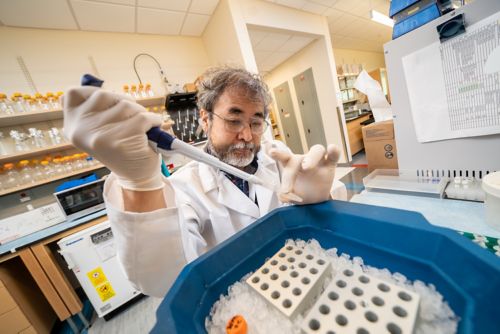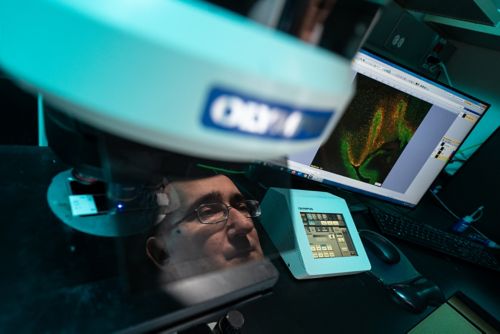St. Jude Family of Websites
Explore our cutting edge research, world-class patient care, career opportunities and more.
St. Jude Children's Research Hospital Home

- Fundraising
St. Jude Family of Websites
Explore our cutting edge research, world-class patient care, career opportunities and more.
St. Jude Children's Research Hospital Home

- Fundraising
Xinwei Cao Lab
Understanding neural progenitor cell regulation and the mechanisms and biological relevance of hypertranscription
About the Cao Lab
Growth—the increase in cell, tissue, and organism size—is one of the most fundamental processes of life. Growth is exquisitely controlled during nervous system development by specific mechanisms. These mechanisms couple with patterning programs to ensure appropriate size, shape, and cytoarchitecture of the nervous system. Dysregulation of these developmental programs leads to malformations and tumorigenesis. Our laboratory is interested in deciphering what these growth control mechanisms are, how they interact with other regulatory mechanisms, and why their disruption leads to catastrophic consequences.

Our research summary
Neural progenitor cells play a key role in neural development. They serve as the source for all neurons and glia and contribute to nervous system histogenesis. Perturbations in neural progenitor functions cause a myriad of diseases, including congenital malformations, neurological disorders, and tumors of the nervous system. Our laboratory investigates the fundamental mechanisms that control neural progenitor properties and functions. We employ a variety of classic and cutting-edge technologies, collaborate with scientists and analysts with complementary expertise, and take advantage of the world-class shared resources at St. Jude. Our efforts help us better understand neural development and the etiology of human diseases caused by neural progenitor dysregulation.
Regulation of neural progenitor cells by the Hippo pathway
The Hippo pathway regulates the development and homeostasis of many tissues in many species. We study the role of the Hippo pathway during vertebrate neural development and focus on YAP/TAZ—transcriptional coactivators and the key effectors of the Hippo pathway. By investigating how YAP/TAZ regulate neural progenitor properties and functions, and how YAP/TAZ are regulated, our study helps us better understand the coordination of growth, morphogenesis, and wiring during brain development.
Developmental progression of subpallial neural progenitor cells
The embryonic ventral telencephalon—the subpallium—is the developmental origin for numerous brain structures and cell populations, such as the basal ganglia and cortical interneurons. These structures and cell populations are critical for higher brain functions and are often causally involved in neuropsychiatric disorders such as schizophrenia, autism, and drug addiction. A better understanding of subpallial development will improve our understanding of brain development and function and help advance treatments of neurological disorders. We investigate the mechanism of action of several transcription factors that regulate subpallial neural progenitor cells. We employ various cutting-edge technologies, such as single-cell RNA-sequencing and CUT&RUN, as well as classic genetics assays.

Molecular mechanisms and biological relevance of hypertranscription
Changes in gene expression are fundamental to cell behavior. In specific contexts, cells can globally upregulate their transcriptomes. This phenomenon, known as hypertranscription, involves a coordinated increase in expression of the majority of the transcriptome. Although evidence suggestive of hypertranscription dates back over 70 years—e.g., in the 1940s–1950s, scientists noted that cancer cells have a higher amount of RNA per cell compared to their normal counterparts—this phenomenon was largely ignored. The landmark discovery that MYC overexpression can induce hypertranscription ignited interest in hypertranscription. Yet, the underlying mechanisms, prevalence, and biological significance of hypertranscription remain largely unknown.
We recently discovered that activation of YAP—the transcriptional coactivator and key effector of the Hippo pathway—boosts global transcriptional activity. Using YAP-driven hypertranscription as our model, we investigate the molecular mechanisms underlying hypertranscription and the physiological and pathological contexts in which hypertranscription occurs. We employ a variety of novel and quantitative technologies, including cell-number–normalized RNA-sequencing and SLAM-seq (which detects nascent transcripts). We explore several development and tumorigenesis models as the biological contexts of hypertranscription. Our study of YAP’s role in hypertranscription will help determine whether inhibiting transcription and RNA processing can serve as therapeutic strategies for cancers with YAP activation.
Tumorigenesis in the nervous system
Dysregulation of growth-control mechanisms often leads to tumorigenesis. During our investigation into how growth is controlled during normal neural development, we generated several genetically engineered models of nervous system tumors. Using these models, we strive to understand why cells respond differently to the same tumorigenic insult since the tumorigenesis phenotype is highly cell-type/state specific. With the knowledge we gain from this work, we hope to further the development of novel therapeutic strategies.
Publications
Contact us
Xinwei Cao, PhD
Associate Member
Department of Developmental Neurobiology
MS 322, Room M2422
St. Jude Children's Research Hospital

Memphis, TN, 38105-3678 USA GET DIRECTIONS